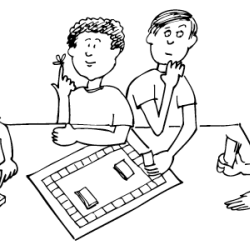Source Institutions
Source Institutions
Add to list Go to activity
Activity link broken? See if it's at the internet archive

In this multi-faceted game (on pages 25-35), learners recreate what happens to creatures in the Brazilian rain forest as they grow from egg to adult—especially those that use fallen, empty Brazil nut pods as a home during some part of their life cycle. These creatures include damsel flies, mosquitoes, toads and poison frogs. The object for players is to make it around the game board, grow faster than the competition, and leave the nutshell nursery before the neighbors eat them. Learners graph the results of all games played. This activity makes a fun connection between life science and math.
- 45 to 60 minutes
- 1 to 2 hours
- 1 cent - $1 per group of students
- Ages 8 - 14
- Activity, Game
- English, Spanish
Quick Guide
Materials List (per group of students)
- 1 die for each game board
- scissors
- pencils
- tape
- markers: green, yellow, red and orange
- copy Chance Cards (p.32) on stiff colored paper
- cut, fold, and tape Critter Game pieces (p.28)
- cut out scorecards (p.31)
Subjects
-
Life Sciences
-
Diversity of Life
- Plants
- Animals
-
Ecology
- Ecosystems
- Biodiversity
-
Diversity of Life
-
Mathematics
-
Data Analysis and Probability
- Data Collection
-
Data Analysis and Probability
-
The Nature of Science
-
The Scientific Process
- Asking Questions
-
The Scientific Process
Informal Categories
- Animals
- Games
Audience
To use this activity, learners need to:
- see
- see color
- read
- touch
Learning styles supported:
- Involves teamwork and communication skills
- Involves hands-on or lab activities
Designed specifically for
- Rural dweller
Culture, ethnicity, and gender
-
Girls
- Explicity developed for this group
Other
Foreign language versions of this resource:
Components that are part of this resource:
Includes alignment to state and/or national standards:
This resource is part of:
Access Rights:
- Free access
By:
Source Collection
- Science After School Consumer's Guide
Rights:
- , University of Nebraska State Museum, 2001
Funding Sources:
- Howard Hughes Medical Institute
- National Science Foundation Informal Science Education Program, 9909496
